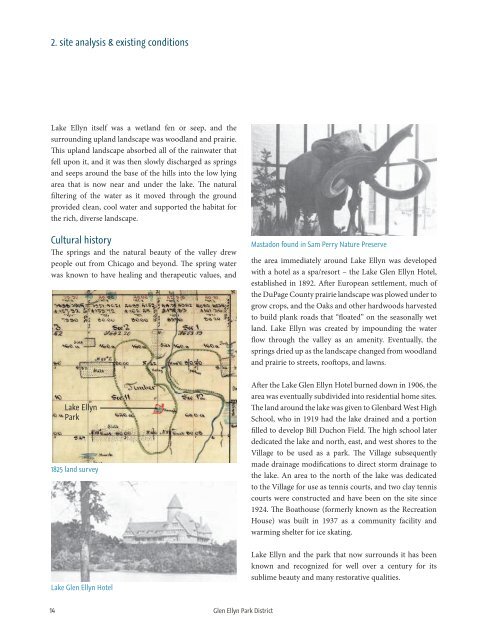Lake Ellyn Park 2013 Master Plan
Lake Ellyn Master Plan Final - Glen Ellyn Park District
Lake Ellyn Master Plan Final - Glen Ellyn Park District
- No tags were found...
Create successful ePaper yourself
Turn your PDF publications into a flip-book with our unique Google optimized e-Paper software.
2. site analysis & existing conditions<br />
<strong>Lake</strong> <strong>Ellyn</strong> itself was a wetland fen or seep, and the<br />
surrounding upland landscape was woodland and prairie.<br />
This upland landscape absorbed all of the rainwater that<br />
fell upon it, and it was then slowly discharged as springs<br />
and seeps around the base of the hills into the low lying<br />
area that is now near and under the lake. The natural<br />
filtering of the water as it moved through the ground<br />
provided clean, cool water and supported the habitat for<br />
the rich, diverse landscape.<br />
Cultural history<br />
The springs and the natural beauty of the valley drew<br />
people out from Chicago and beyond. The spring water<br />
was known to have healing and therapeutic values, and<br />
<strong>Lake</strong> <strong>Ellyn</strong><br />
<strong>Park</strong><br />
1825 land survey<br />
Mastadon found in Sam Perry Nature Preserve<br />
the area immediately around <strong>Lake</strong> <strong>Ellyn</strong> was developed<br />
with a hotel as a spa/resort – the <strong>Lake</strong> Glen <strong>Ellyn</strong> Hotel,<br />
established in 1892. After European settlement, much of<br />
the DuPage County prairie landscape was plowed under to<br />
grow crops, and the Oaks and other hardwoods harvested<br />
to build plank roads that “floated” on the seasonally wet<br />
land. <strong>Lake</strong> <strong>Ellyn</strong> was created by impounding the water<br />
flow through the valley as an amenity. Eventually, the<br />
springs dried up as the landscape changed from woodland<br />
and prairie to streets, rooftops, and lawns.<br />
After the <strong>Lake</strong> Glen <strong>Ellyn</strong> Hotel burned down in 1906, the<br />
area was eventually subdivided into residential home sites.<br />
The land around the lake was given to Glenbard West High<br />
School, who in 1919 had the lake drained and a portion<br />
filled to develop Bill Duchon Field. The high school later<br />
dedicated the lake and north, east, and west shores to the<br />
Village to be used as a park. The Village subsequently<br />
made drainage modifications to direct storm drainage to<br />
the lake. An area to the north of the lake was dedicated<br />
to the Village for use as tennis courts, and two clay tennis<br />
courts were constructed and have been on the site since<br />
1924. The Boathouse (formerly known as the Recreation<br />
House) was built in 1937 as a community facility and<br />
warming shelter for ice skating.<br />
<strong>Lake</strong> Glen <strong>Ellyn</strong> Hotel<br />
<strong>Lake</strong> <strong>Ellyn</strong> and the park that now surrounds it has been<br />
known and recognized for well over a century for its<br />
sublime beauty and many restorative qualities.<br />
14 Glen <strong>Ellyn</strong> <strong>Park</strong> District




